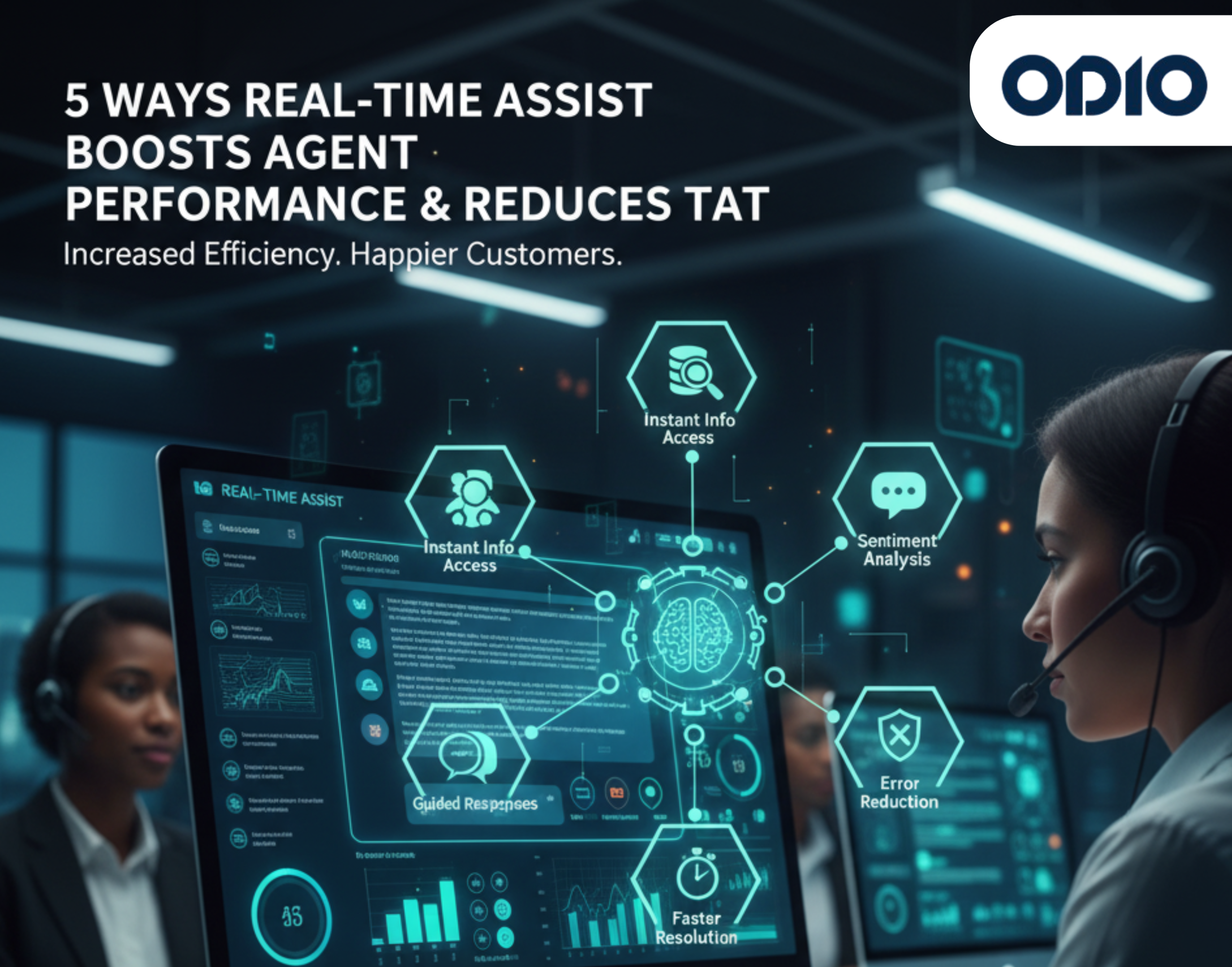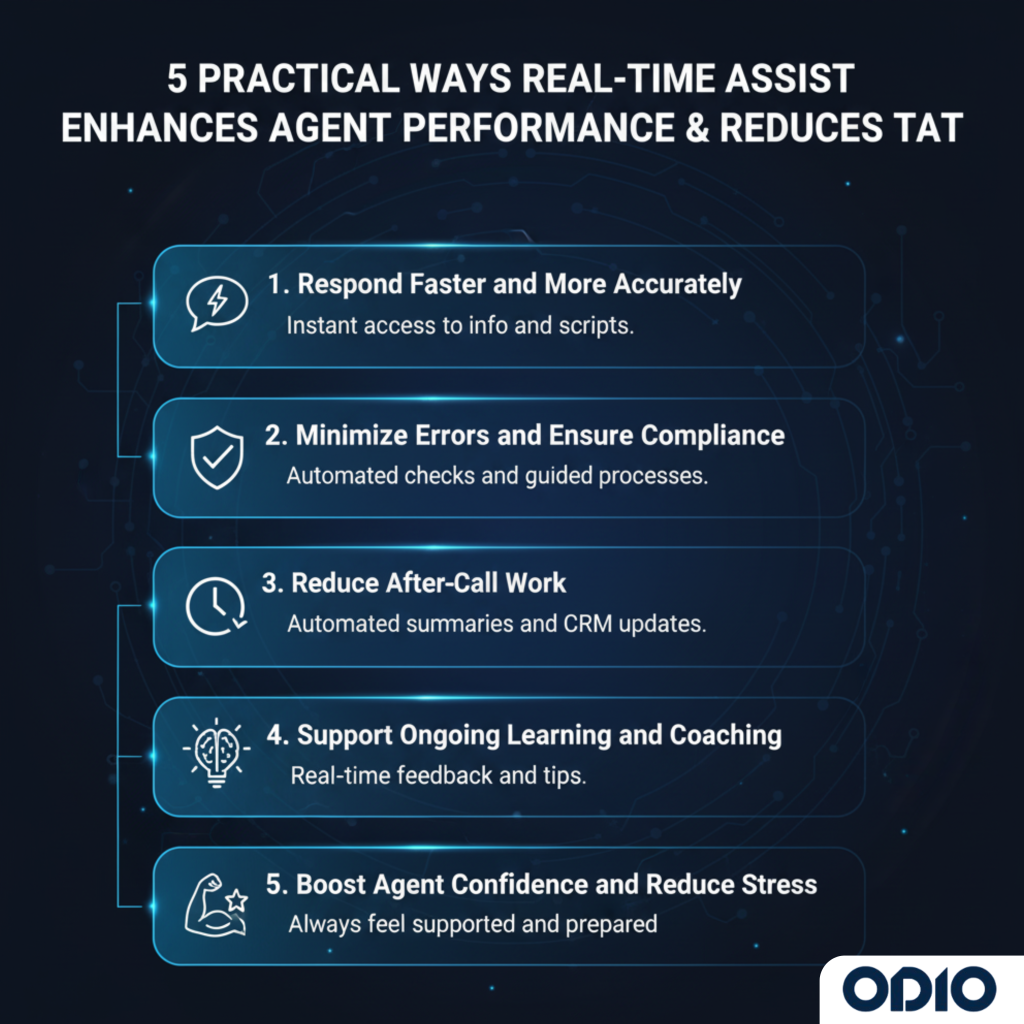
Introduction
In today’s high-expectation world, customers want answers fast. For contact centres and support teams, that means reducing delays wherever possible. That’s where Real-Time Assist comes in, an AI-powered tool that helps agents while they’re on the call, guiding them step by step.
In this post, we’ll explore 5 ways Real-Time Assist boosts agent performance and slashes Turnaround Time (TAT). You’ll see how it’s not just a fancy add-on it becomes a real game changer in customer experience and operational efficiency.
Let’s dive in.
What is Real-Time Assist (RTA)?
Before the “how,” let’s clarify the “what.”
Real-Time Assist is a tool (often backed by AI / conversational intelligence) that listens to the live conversation between an agent and customer. It provides contextual, on-screen suggestions, hints, alerts, or prompts-helpful steps exactly when the agent needs guidance.
Think of it as a coach whispering helpful tips while the match is ongoing, not just afterward.
Some common features of Real-Time Assist:
- Live transcription and intent recognition (so the system “understands” what the customer is saying).
- Prompting relevant knowledge articles, scripts, or next-best responses.
- Compliance / regulatory alerts (if the agent is about to say something disallowed or misses a required disclosure).
- Automated tasks like summarizations, note captures, or populating fields (reducing after-call work).
Now, let’s see how these features translate into real benefits.
1. Faster, More Accurate Responses
How it works: Real-Time Assist acts like a guide, offering helpful suggestions to agents during live conversations. Instead of flipping between multiple systems or digging through manuals, agents see relevant responses, product details, or scripts right when they need them.
Benefit: Agents can provide accurate answers almost instantly. This not only keeps customers satisfied but also shortens each interaction.
Result: Faster resolutions mean a lower Turnaround Time (TAT) and smoother customer experiences. For example, if a customer asks about a refund, the agent immediately gets the policy details and step-by-step instructions, avoiding pauses and repeated follow-ups.
2. Fewer Errors & Better Compliance
How it works: Real-Time Assist reminds agents of key policies, required disclosures, or sensitive points they must address during the conversation.
Benefit: Agents feel confident they are following the correct procedures, reducing mistakes that could require follow-up calls or escalations.
Result: Customers receive accurate, consistent information, while agents avoid stressful errors. This builds trust with both customers and the team.
3. Reduced After-Call Work (ACW) – which cuts overall TAT
How it works: Real-Time Assist can automatically summarize conversations, draft follow-up notes, or fill ticket information as the call progresses.
Benefit: Agents spend less time on administrative tasks after each call, freeing them to handle more customer interactions.
Result: The total time spent per case (including wrap-up) decreases, directly contributing to a lower TAT. Customers get answers sooner, and agents feel less burdened by paperwork.
4. Better Performance, Faster Coaching
How it works: Real-Time Assist acts like a live mentor, providing subtle tips on tone, phrasing, or handling difficult situations during calls.
Benefit: Agents learn in real time, improving their skills faster than traditional post-call coaching. Over time, they become more confident and capable without extra training sessions.
Result: A more skilled team handles interactions efficiently, which reduces call duration and improves overall performance. Agents also feel valued and supported, which boosts morale.
5. Increased Confidence & Lower Stress
How it works: Knowing they have real-time guidance, agents can focus on the conversation instead of worrying about making mistakes or missing steps.
Benefit: Reduced stress leads to better focus, fewer errors, and smoother interactions.
Result: Confident agents handle calls faster, escalate less often, and provide a better overall customer experience-which naturally reduces TAT.

Bringing It Together: Real-Time Assist → Lower TAT
Real-Time Assist helps agents perform at their best in the moment, streamlining both conversation and follow-up. By combining faster responses, fewer errors, reduced administrative work, and ongoing coaching, your team can handle calls efficiently without sacrificing quality.
The result: Lower Turnaround Time, improved customer satisfaction, and happier, more confident agents.
All of this combines to reduce your end-to-end Turnaround Time (from when a call begins to full resolution), meaning more calls handled, happier customers, and smoother operations.
Best Practices for Adopting Real-Time Assist
To get the most from Real-Time Assist, here are a few tips:
- Start with a pilot– choose one high-impact workflow or use case (e.g. refunds, billing)
- Feed it real data– train with your own transcripts, scripts, policies
- Integrate into agent desktop– seamlessly avoid forcing agents to switch windows
- Balance AI and human coaching– don’t treat it as a replacement; use it to complement coaching
- Track metrics continuously– TAT, Average Handle Time (AHT), First Contact Resolution (FCR), agent satisfaction
- Iterate and refine– badjust suggestion rules, prompts, content, thresholds
Conclusion
Real-Time Assist isn’t just a “nice to have” when implemented well, it becomes a force multiplier. It helps agents perform better at the moment, reduces wastes (searching, wrap-up, errors), and accelerates how fast calls are handled. Over time, your entire support operation becomes leaner, more consistent, and more scalable.
Ready to see Real-Time Assist in action? Book a demo with ODIO today and start cutting your TAT.

